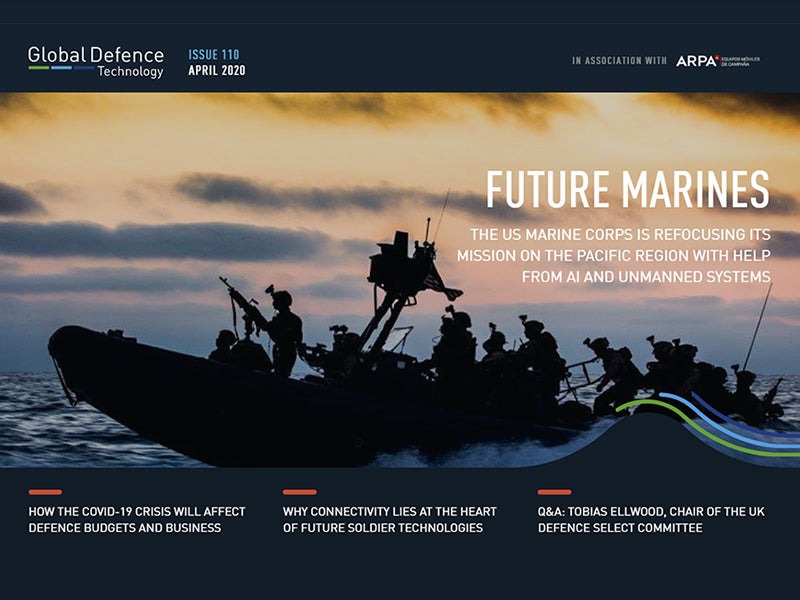
Global Defence Technology is back for another issue packed with industry news and analysis. In this issue, we find out how US Marine Corps plans to tackle China’s dominance in the Pacific with help from AI and unmanned systems, speak to UK Defence Select Committee chair Tobias Ellwood, explore the impact of Covid-19 on defence budgets and business, and more.
Whether you are on a desktop, tablet or smartphone, you can read the magazine for free online.
How well do you really know your competitors?
Access the most comprehensive Company Profiles on the market, powered by GlobalData. Save hours of research. Gain competitive edge.

Thank you!
Your download email will arrive shortly
Not ready to buy yet? Download a free sample
We are confident about the unique quality of our Company Profiles. However, we want you to make the most beneficial decision for your business, so we offer a free sample that you can download by submitting the below form
By GlobalDataThe US Marines has embarked on a ten-year makeover to return to its roots as an island-hopping, pacific-dominating force. We find out more about this strategic shift and the technologies that will help shape the marines of the future.
We also take a look at current trends in soldier technology, explore how technology can help make live military training safer, and chat with Tobias Ellwood MP, former UK Defence Minister and now chair of the government’s Defence Select Committee, about emerging threats and whether the UK is equipped to meet them.
Plus, we find out how defence departments and industry are using commercial simulation software to support equipment development and logistics, talk to Raytheon about its modular Spy-6 family of radars for the US Navy, and look into the recent resurgence of nuclear weapons around the world.
In this issue
Covid-19 briefing & analysis
In our new Covid-19 section we take a look at the latest news and figures and hear from GlobalData’s analysts how the pandemic is impacting defence budgets and business.
Safety first: protecting personnel during live military training
Realistic training remains the closest thing troops can get to operational experience, but the risks it poses are evident in the number of fatal training accidents that occur every year. Julian Turner looks at the biggest risks involved in live exercises, and technologies employed to prepare personnel for combat without putting them in harm’s way.
Connectivity: the heart of the future soldier
Networks are now widely seen as the key element in combat, be it on a tank, ship, or aircraft, or indeed at the soldier level. At SMI Group’s Future Soldier Technology 2020, Harry Lye learned what the future connected soldier will look like from the British, Spanish, Finnish and Swiss armed forces.
Q&A: Tobias Ellwood, chair of the House of Commons Defence Select Committe
Harry Lye sat down with Tobias Ellwood MP, former Defence Minister and now chair of the defence select committee, to get his thoughts on emerging threats and whether the UK has what it needs to defend itself.
Using COTS software to model development and logistics
Commercial off-the-shelf software is becoming more common in the defence industry, with Armed Forces and Industry exploiting its potential to make better decisions. Harry Lye attended a Command PE training event to find out how the software is being used by the armed forces.
The renaissance of the nuclear deterrent
In an era of faltering nuclear treaties, the US has requested $29bn funding for upgrades to its nuclear arsenal, while the UK is charging ahead with its own deterrent and France is calling for stronger defences in Europe. Harry Lye takes a look inside the new nuclear renaissance.
AI and UAS will shape the US Marines in the future
The US Marines has embarked on a ten-year makeover to return to its roots as an island-hopping, Pacific-dominating force. As the corps moves towards distributed operations and long-range fires, Harry Lye finds out how AI can help the US Marines keep up with the rise of China.
HMS Prince of Wales in numbers
The UK’s newest aircraft carrier is the biggest ship in the fleet. Here we take a look at the sheer scale of the HMS Prince of Wales.
How Raytheon’s modular SPY-6 radar supports US Navy vessels of all sizes
Raytheon’s SPY-6 family of integrated, scalable radars offers the US Navy protection against ballistic and cruise missiles, hostile aircraft and surface vessels. Scott Spence, senior director of naval radar systems at Raytheon Naval Programme, tells Berenice Baker how SPY-6’s modular approach will future-proof the fleet’s defences.
Next issue preview
Military bases are in need of an upgrade, especially when it comes to establishing seamless connectivity across military operations. We hear from Honeywell how connectivity, asset management and operational control solutions can help to equip the base of the future.
We also find out how the defence industry has reacted to the cancellation of Eurosatory and other key events, and explore other aspects of the business impact of the Covid-19 pandemic on the defence sector.
Also in the next issue, we find out how advances in unmanned underwater vessels are transforming mine hunting and mine clearance operations, and speak to Dstl about its project to combat illegal maritime activity with new virtual engineering technology.
Plus, we chat with Neil Fraser, NSSLGlobal’s new director for defence and space and a 26-year veteran of the British Army, about his work on satcom for the MOD and how he will use his military experience in his new role in the private sector.
Subscribe to be notified when the next issue of GDT is available.
Visit our archive to read past issues for free.




